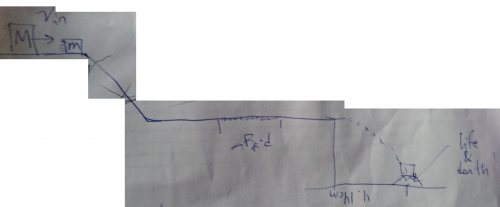The page you are reading is part of a draft (v2.0) of the "No bullshit guide to math and physics."
The text has since gone through many edits and is now available in print and electronic format. The current edition of the book is v4.0, which is a substantial improvement in terms of content and language (I hired a professional editor) from the draft version.
I'm leaving the old wiki content up for the time being, but I highly engourage you to check out the finished book. You can check out an extended preview here (PDF, 106 pages, 5MB).
Mechanics example
It is winter and everything is covered in snow. You are standing at the top of the roof of a building and want to use a sleigh to jump off the side of the building and land safely on a big pile of snow that is waiting for you.
The setup is as follows. The pile of snow is 20m away from the flat part of the building, and the lowest part of the roof has a height of 15m. This means that you have to reach the edge of the roof with quite a bit of speed in order to land on the snow pile.
To pick up speed, you can start from a surelevated part of the roof which conveniently slopes down. The surelevated part is 20m above flat part of the roof. You have it all planned out. You will place the sleigh right at the edge of the surelevated part and run up to it as fast as you can, and then jump into it. With your initial momentum, and the speed you will pick up down the slope you should be able to make it safely to the snow pile. You certainly hope so, since there is nothing but hard pavement around the snow pile which would hurt to land on.
You can assume that the snow is really slippery, so there will be no friction to slow you down except for one rough patch of $3$m where the snow coverage is not perfect and so kinetic coefficient of $\mu_k=0.2$ will come into play.
The sleigh weights 30kg, you weigh 70kg. How fast should you run before you jump into the sleigh in order to land exactly on the snow pile?
Your knowledge of mechanics will come in handy for this.
part C: kinematics
part B: energy
part A: momentum
Life or death situation

